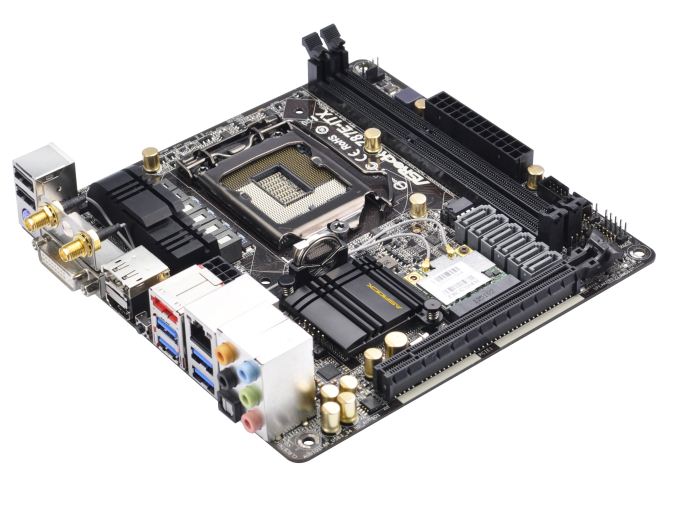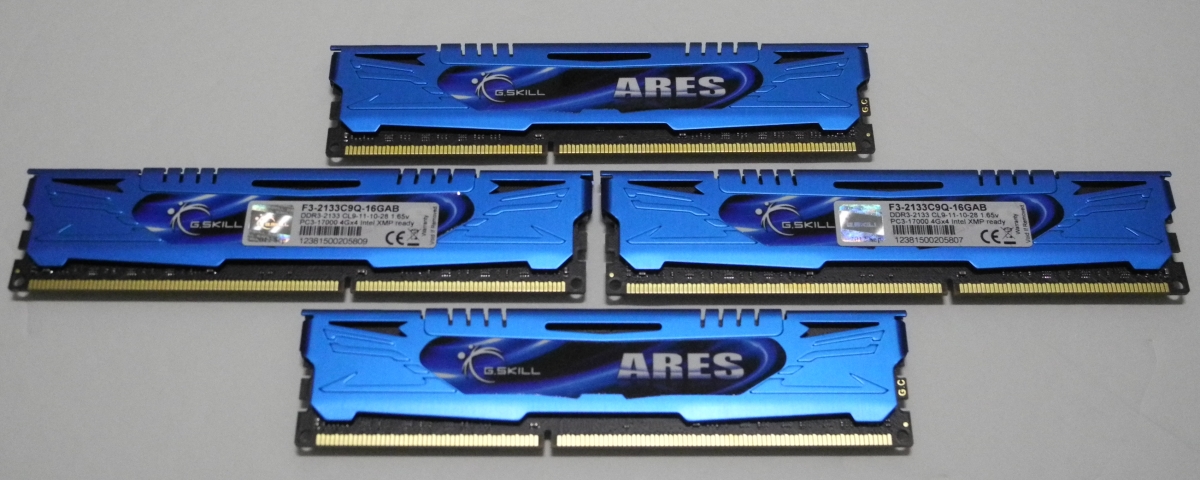Intel's Haswell - An HTPC Perspective: Media Playback, 4K and QuickSync Evaluated
by Ganesh T S on June 2, 2013 8:15 PM ESTTestbed and Software Setup
Instead of going for the usual high end CPU (77W / 95W TDPs), we have opted for the Core i7-4765T for today's review. This is a 35W TDP CPU with four cores / eight threads, expected to retail with a MSRP of $303. Intel has a number of GPU configurations doing the rounds at Haswell launch. The i7-4765T sports the HD 4600 GPU, and it is the best GPU available in a LGA 1150 configuration (The Iris Pro 5200 GPUs are reserved for BGA configurations and unavailable to system builders).
The table below presents the hardware components of our Haswell HTPC testbed
| Haswell HTPC Testbed Setup | |
| Processor | Intel Core i7-4765T - 2.00 GHz (Turbo to 3.0 GHz) |
| Intel HD Graphics HD4600 - Up to 1200 MHz | |
| Motherboard | ASRock Z87E-ITX mITX |
| OS Drive | Seagate 600 SSD ST240HM000 240GB |
| Memory | G.SKILL Ares Series 8GB (2 x 4GB) SDRAM DDR3 2133 (PC3 17000) F3-2133C9Q-16GAB CAS 9-11 -10-28 2N |
| Optical Drive | ASUS 8X Blu-ray Drive Model BC-08B1ST |
| Case | Antec Skeleton ATX Open Air Case |
| Power Supply | Antec VP-450 450W ATX |
| Operating System | Windows 8 Professional x64 |
| Displays / AVRs | Onkyo TX-SR606 + Acer H243H |
| Pioneer Elite VSX-32 + Sony Bravia KDL46EX720 | |
| Sony XBR-84X900 | |
| Seiki Digital SE50UY04 | |
The ASRock Z87E-ITX board comes with a Broadcom-based 802.11ac 2T2R solution. Connected to a Buffalo WZR-D1800H 802.11ac router, I was able to consistently obtain 173 Mbps of practical throughput. Streaming Blu-ray ISOs over Wi-Fi from a NAS worked without issues. The board was very simple to get up and running and given its form factor and the CPU currently installed, I hope to migrate it to a passive HTPC build soon.
The Haswell platform officially supports DDR3-1600. Towards this, we obtained a 16 GB DDR3-2133 Ares kit from G.Skill for our testbed. The Ares kit supports XMP 1.2 and the ASRock Z87E-ITX had it running at 2133 MHz flawlessly on first boot. However, we made sure to run the memory at the suggested 1600 MHz in order to obtain results consistent with what an average system builder (non-overclocker) would obtain. The Ares kit makes it possible to study HTPC behaviour from a memory bandwidth perspective, but we will not cover that aspect in this launch piece.
The software setup for the Haswell HTPC testbed involved the following:
| Haswell HTPC Testbed Software Setup | |
| Intel Graphics Driver | 9.18.10.3107 (Version on ASRock Motherboard DVD) |
| Blu-ray Playback Software | CyberLink PowerDVD 13 |
| Media Player | MPC-HC v1.6.7.7114 |
| Splitter / Decoder | LAV Filters 0.57 |
| Renderers | EVR / EVR-CP (integrated in MPC-HC v1.6.7.7114) |
| madVR v0.86.1 | |
The madVR renderer settings were fixed as below for testing purposes:
- Decoding features disabled
-
Deinterlacing set to:
- automatically activated when needed (activate when in doubt)
- automatic source type detection (i.e, disable automatic source type detection is left unchecked)
- only look at pixels in the frame center
-
Scaling algorithms were set as below:
- Chroma upscaling set to SoftCubic with softness of 100
- Luma upscaling set to Lanczos with 4 taps with anti-ringing filter left deactivated and scale in linear light left unchecked / DXVA2
- Luma downscaling set to Lanczos with 4 taps with anti-ringing filter left deactivated and scale in linear light left unchecked / DXVA2
-
Rendering parameters were set as below:
- Automatic fullscreen exclusive mode was used
- CPU and GPU queue sizes were set to 32 and 24 respectively
- Under exclusive mode settings, the seek bar was enabled, switch to exclusive mode from windowed mode was delayed by 3 seconds and 16 frames were configured to be presented in advance. The GPU flushing modes were set to default
- Smooth motion was left disabled
- The 'trade quality for performance' settings were left at default (i.e, linear light was left disabled for smooth motion frame blending and custom pixel shader results were stored in 16-bit buffers instead of 32-bit)
Unlike our Ivy Bridge setup, we found the windowed mode to be generally bad in terms of performance compared to exclusive mode.
MPC-HC and LAV Filters settings were altered from the defaults as below for testing purposes:
- DirectShow Video Output was configured as EVR / EVR-CP / madVR under Options > Playback > Output
- All internal source and transform filters were disabled under Options > Internal Filters
- Under Options > External Filters, LAV Splitter, LAV Audio Decoder and LAV Video Decoder were added as Preferred filters
- LAV Audio Decoder was set to bitstream all applicable formats
-
LAV Video Decoder were altered from the defaults as below
- Hardware Acceleration was set to DXVA2 Native / QuickSync / None depending on the aspect being tested. UHD (4K) was enabled in all the cases
- Deinterlacing mode was set to 'Aggressive'












95 Comments
View All Comments
eio - Sunday, June 23, 2013 - link
great example! very interesting.I agree with Montage that for most snapshots, HD4600 is significantly better than HD4000 for retaining much more texture, even for this frame 4 in 1080p.
but in 720p HD4600 shows its trade off of keep more fine grained texture: looks like HD4600 are regressed in low contrast, large scale structral infomation.
as you said, this type of regression can be more evident in video than snapshots.
eio - Sunday, June 23, 2013 - link
another thing that surprises me is: x264 is a clear loser in this test. I don't understand why, what are the specific params that handbrake used to call x264?nevcairiel - Monday, June 3, 2013 - link
@ganeshtsI'm curious, what did you use for DXVA2N testing of VC-1?
LAV Video doesn't support VC-1 DXVA2 on Intel, at least on Ivy Bridge, and i doubt Haswell changed much (although it would be a nice surprise, i'll see for myself in a few days)
ganeshts - Monday, June 3, 2013 - link
Hendrik,I made a note that DXVA2N for interlaced VC-1 has software fallback.
That issue is still not fixed in Haswell. That is why you see QuickSync consuming lower power compared to DXVA2N for the interlaced VC-1 sample.
zilexa - Monday, June 3, 2013 - link
To be honest, now that I have a near-perfect Raspberry setup, I would never buy a Core ix/AMD Ax HTPC anymore. Huge waiste of money for almost un-noticable image quality improvement.The Raspberry Pi will use max 6.5w, usually much lower. Speed in XBMC is no issue anymore, and it plays back all my movies just fine (Batman imax x264 rip 7-15MBps). I play mostly downloaded tv shows, streams and occasionally a movie. It also takes care of the whole download process in the background. So I don't even have a computer anymore at home. I sold my old AMD 780G based Silverstone M2 HTPC for €170 and it was the best decision ever.
Still cool to read about the high end possibilities of HTPC/MadVR or actually just video playback and encoding, cos thats what this is really about. But I would never buy a system to be able to support this. HTPC in my opinion is to be in a lazy mode and able to playback your shows/movies/watch your photos and streams in good HD quality and audio.
If you need HTPC, in my opinion there is no need for such an investment in a computer system which is meant for a huge variety of computing tasks.
jwcalla - Monday, June 3, 2013 - link
It's going to depend on individual needs of course, and I think your Raspberry Pi is on the other end of the extreme, but otherwise I kind of have the same reaction. This has got to be an $800+ build here for an HTPC and then I begin to wonder if this is a practical approach.Owing to the fact that Intel's entire marketing strategy is to oversell to the consumer (i.e., sell him much more than he really needs), it seems that sometimes these reviews follow the strategy too closely. For an HTPC? Core i3 at the max. And even that's being generous. If one needs certain workloads like transcoding and such then maybe a higher end box is needed. But then I question if that kind of stuff is appropriate for an HTPC.
superjim - Monday, June 3, 2013 - link
Playback a raw M2TS 1080p 60fps file on your Pi and get back to me.phoenix_rizzen - Monday, June 3, 2013 - link
How did you get around the "interface is not accelerated" issue on the RPi? I found it completely useless when trying to navigate the XBMC interface itself (you know, to select the show to watch). Sure, once the video was loaded, and processing moved over to the hardware decoder, things ran smooth as silk.I sold my RPi two weeks after receiving it due to this issue. Just wasn't worth the headaches. Since moved to a quad-core AthlonII running off an SSD with a fanless nVidia dGPU. So much nicer to work with.
vlado08 - Monday, June 3, 2013 - link
What about Frame Rate Conversion (FRC) capability?ericgl21 - Monday, June 3, 2013 - link
Ganesh,Let's assume you have two 4K/60p video files playing in a loop at the same time for a duration of 3 hours.
Is it possible that Iris or Iris Pro could play those two video streams at the same time, without dropping frames and without the processor throttling throughout the entire movie playback ?
I mean, connecting two 4K TVs, one to the HDMI port and the other to the DisplayPort, and outputting each video to each TV. Would you say the Iris / Iris Pro is up to this task? Could you test this scenario?